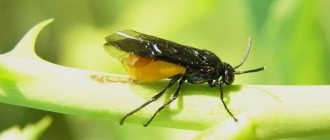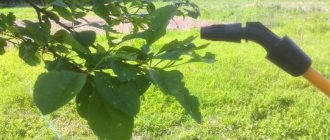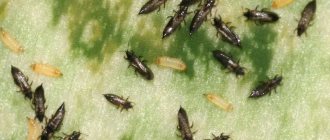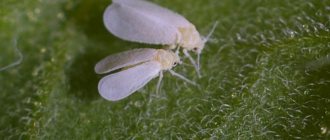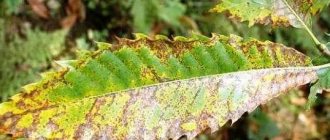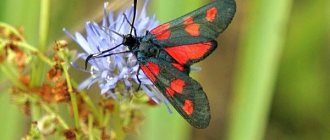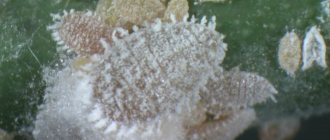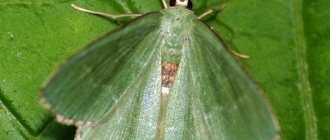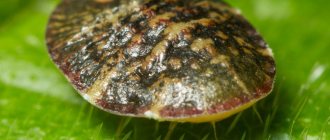Flower growers who breed houseplants very often encounter various types of pests, which need to not only get rid of, but also take preventive measures against them. One of these pests are thrips, which are found almost as often as spider mites.
The main danger of thrips is that they are omnivorous (polyphagous). They will easily “drink” any of your plants, regardless of its type and class. In addition, they multiply very quickly, and if action is not taken in time, you will lose all the plants in the house.
Thrips are a group of incredibly small insect pests. Typically they range in size from 1 mm to 30 mm, but there are also types 1.5 cm in length. These pests have an asymmetrical, piercing-sucking mouth, with which they “suck the life” out of the plant. Tris legs are not designed for jumping, but they have “suckers” and “notches”, due to which insects run and climb very quickly. They are usually dark in color (black, gray, burgundy).
Thrips are also called club-legged, vesicular-legged or fringed-winged, so if you showed the plant to a specialist and he gave it a similar “diagnosis”, don’t be too wise. These are all names of these pests.
They were first described about 300 years ago, but since then scientists have discovered more than 6,000 species of these pests. These pests reproduce quite quickly, and also quickly go through all 5 stages of their development:
- Eggs
- Larvae
- Pronymphs
- Nymphs
- Imago
As a matter of fact, thrips will harm the plant even if they are in the eggs, and the difference between the larva and the imago is only in the presence of wings, at the last stage, and in color. They are also dangerous in floriculture because it is almost impossible to destroy them. Especially in greenhouses. The most you can do is keep their numbers down.
What happens to a flower affected by thrips?
Given the size of thrips, they are almost impossible to detect. And they behave quietly. They hide on one plant for a long time, gradually biting it and sucking the juices out of it, starting from the larval stage. In addition, thrips secrete their harmful mucus into the plant, thereby damaging it.
The first signs may not begin to appear very soon. It usually starts with small spots, light yellow or pale in color. Gradually, in addition to spots, small stripes will appear. And the spots and stripes will become more and more numerous as the number of parasites increases.
Biological portrait of a small pest
Tobacco thrips is distributed almost throughout the globe, with the exception of the polar regions. It affects more than 100 different plant species from a wide variety of families.
How to identify a pest
In your garden, you should use a magnifying glass to identify insects. The pest is distinguished by the following characteristic features.
Appearance of an adult:
- sizes vary in the range of 0.5-1.5 mm;
- the color is represented by a yellow color palette: from light to rich dark, males have a lighter shade in comparison with females;
- on the thin elongated body the separate head, chest, and abdomen are clearly visible;
- well-developed narrow wings with a fringe of hairs along the edge and legs of a pale yellow color, thighs and legs of a gray color.
On a note! The main difference between tobacco thrips and other species is the translucent first segment of the antennae and the presence of setae on the fore wings. If you lightly touch the adults sitting under the leaf, they begin to actively jump short distances.
The larva is similar in appearance to its parents, but is characterized by smaller size and the absence of wings. Newborns are whitish in color and become yellow-green as they mature.
Causes of thrips
As a matter of fact, the main reason for the appearance of thrips is their hunger. Parasites also want to eat. The main thing is that you must understand that thrips do not start on their own. You can only bring them into the house in different ways.
Most often, thrips enter homes and areas in the following way:
- They fly through windows when you ventilate the room. They can also simply be blown towards you by the wind. Thrips are capable of migration, however, they are still not storks that can fly 1000 km.
- Thrips can move to you from neighbors in your garden or apartment.
- Be careful when purchasing a new plant. Examine it carefully, because... thrips are very difficult to detect, otherwise you will spread them throughout the house.
- In the same way, carefully examine the plant that you picked somewhere in the garden or in the field.
Be most wary of thrips in hot, dry regions, as this is where these pests are most common. Heat, dryness and summer wind are ideal conditions for thrips to appear.
Signs of infection: bites and black spots
If an orchid is infected with thrips, the following signs will indicate this:
- multiple leaf damage and punctures;
- silver webs, discolored scars and yellowed areas;
- the growth of black-brown paths that appear from insect bites;
- waste products of the pest accumulate on the leaves (dark spots);
- flowering shoots, buds and young leaves are deformed;
- pollen forms on freshly bloomed flowers;
- necrotic and putrefactive darkened spots are observed on peduncles, leaves and stems.
How to spot thrips
Most thrips species lead a hidden lifestyle, making them almost impossible to detect. Even gardeners with many years of experience do not always manage to notice the parasite in time. And how can you spot it when it’s hidden, for example, between the scales of an onion? However, there are ways that will allow you to identify the problem:
- Daily inspection.
- Pay special attention to inspecting the leaves from the reverse side. Thrips suck the juices out of the plant, so it is on the back of the leaves that the first spots will appear. Small holes in the leaves are a sign of the pest.
- The leaves will begin to fade, but this is already a more advanced stage of the parasite’s “work.”
- There may be mucus on the leaves and stem that sticks to your hands. This is a clear sign of a pest.
- Presence of silvery spots and stripes.
- Withering of buds.
- Deformation of the stem, flowers and leaves.
- The plant begins to bloom later than usual, and goes into “hibernation” earlier.
Features of development
In their natural habitat, tobacco thrips overwinter under plant debris in the upper layers of soil at a depth of 5-6 cm. If the insects get into storage with onions, they successfully overwinter in comfortable conditions under the scales of the bulbs, causing them damage. With the arrival of spring, in mid-April, the primary source of nutrition for overwintered individuals is weeds; in greenhouses and greenhouses, green onions planted on a feather. In the northern regions, thrips appear on plants in early May. Subsequently, the insects settle on seedlings and, in the field, move to tobacco plantations.
It is noteworthy that pests can rarely be found on old or too young leaves. They prefer to be localized on the lower part of formed leaves. Having replenished the body with nutrients, tobacco thrips begin to mate. The female lays eggs in portions of 3-4 pieces. in a day. The total fertility of a female individual is limited to 100 eggs and depends on the food supply and temperature conditions.
On a note! Drought and insufficient humidity are optimal conditions for the development of tobacco thrips. But too high temperatures from 40°C are destructive for them.
The female places the eggs one at a time under the skin in the tissue of the leaves of the plants on which feeding occurred. After 3-7 days, larvae appear and need nutritional components. After 10 days, the larval stage ends, and the young individuals go into the soil to a depth of 10-15 cm. Literally after 3 days, winged thrips appear, which immediately attack the plants and continue the development of the population.
From 6 to 10 generations are possible per year. The mass peak of reproduction and distribution occurs at the end of June and beginning of August.
How to get rid of thrips
Initially, you must move the infected plant to a quarantine area. You will treat it as expected, and with the rest, if there are no noticeable signs of the pest, you will take preventive measures.
The infected plant must be “souled”, because thrips have an extremely negative attitude towards moisture.
Remove the top layer of soil from the pot and throw it away, or even better, replant the plant in a freshly purchased or prepared soil mixture.
Only after this can you start using special or folk remedies. The first ones help better, but the second ones are more gentle.
Where do they come from?
During the warm season, thrips can be brought into a house from the street , dacha, along with a bouquet of peonies or roses, for which they have a special weakness. They can fly in on their own, for example, through a balcony from a flower bed located under the windows. You can bring the insect in a bag, on clothes or a bunch of any greenery that falls under the almost unlimited diet of thrips, as well as with purchased ornamental plants, where they can hide in the soil, in buds or near the inflorescences.
Preventative measures against the appearance of thrips
Recommended by topic
How to get rid of rust on plant leaves How to get rid of spider mites on indoor plants How to get rid of scale insects on indoor plants
Go back to the beginning of the article and re-read the ways thrips get into your home. It is clear that it is physically impossible to protect yourself from everything, especially if you have a garden outside. But installing a net on a window, or inspecting a plant before bringing it into the house is not difficult, especially if it protects your other plants. In addition, it is recommended to observe other preventive and precautionary measures:
- Care for your plants properly. Distribute them correctly among the rooms. There is no need to keep a vine that loves high humidity and water in the same room with chlorophytum and sansevieria, which are the complete opposite of it.
- Thrips love drought, so pay extra attention to drought-resistant plants. In addition, pests can also arise from lack of watering.
- Use folk remedies. Spray the plant with them periodically so as not to encounter trisps, which are very difficult to remove.
- Always inspect the plants. It’s better to spend 5-10 minutes a day on inspection than to lose your entire home plantation. Timely detection of the pest guarantees its death and the life of the flower.
Thrips are a common and extremely dangerous pest. Not only does he personally kill the plant, but he can also infect it with a viral disease that is incurable and will kill the flower. The sooner you detect it, the sooner you take action, the greater the chance that you will save the plant. Well, you already know how to do this from our article.
Prevention
To avoid having to spend money and time fighting very tenacious insects, preventive measures will help. Keep your green garden clean. Water the plants regularly, but do not create a “swamp”. Inspect the soil periodically. Check the trunk, flowers and leaf mass. At the first suspicion of an infestation, try to find out exactly the type of pest and begin fighting them.
Very often, thrips enters an apartment with presented bouquets. Try to keep them separate from indoor plants. If possible, take it out onto the balcony and carefully examine the bouquet you brought. Even if all preventive measures are carefully observed, there is no complete guarantee that plants will not be attacked by thrips. If this problem occurs, take every precaution to ensure your houseplant remains healthy.
"Fitoverm"
The product will need to be diluted in two hundred milliliters of warm water. For one treatment, two milliliters of the drug is enough.
The liquid should be sprayed onto the affected areas. For better concentration, it is necessary to cover the plant with a transparent polyethylene film. The protection can be removed after 24 hours.
"Vertimek"
To make the solution, you need to mix two and a half milliliters of the product in ten liters of water. The drug can be used in all crop zones. To enhance the effect, you need to use a protective cover.
"Agravertine"
Less effective drug. Reducing the thermometer mark below + 18 degrees reduces the concentration of the product. For half a liter of water you will need five milliliters of natural insectoacaricide. It is recommended to use a plastic bag during the day.
"Aktelik"
It has a strong unpleasant odor. Not recommended for use indoors with insufficient air circulation. For processing, you will need to dissolve the ampoule in one liter of water. Polyethylene facilitates the penetration of the drug into plant tissue.
Pheromone traps are also used to successfully combat thrips.
Here's how they work: a capsule containing a synthesized sex pheromone is placed in a trap with a sticky bottom. The attractant attracts male thrips, they fly into the trap and stick. Pheromone traps make it possible to constantly monitor the number of pests and, acting as an indicator, make it possible to predict the damage caused by the pest, which helps to apply insecticides most effectively.
Using sticky traps against thirps
One of the simplest, most convenient and at the same time quite objective methods for monitoring phytophages is the use of yellow glue traps. They are used to monitor both thrips and whiteflies, as well as leaf miners and aphids. Traps are placed 30 cm above the crop, the norm is 50 pieces/ha. It is effective to place diagnostic traps in places where pests are likely to be localized: along heating circuits, at the entrance to the greenhouse, near central paths. The most effective means of physically controlling pest populations are roll-on glue traps.
The main purpose of this type of trap is mass mechanical catching of pests. Due to the large adhesive surface area, this product is effective both with low and high thrips populations.
Chemicals or poisoning?
- Insektor is an enteric contact insecticide. The product is diluted at the rate of 0.5 ml of suspension per 5 liters of water. The resulting composition is poured over the orchid substrate. The poison remains in plant tissue for a long time, which helps protect the plant from re-infection.
- Aktara is a fast-acting contact-intestinal insecticide. 8 g of the drug must be dissolved in 10 liters of liquid. The resulting composition is used to water the soil and carry out foliar irrigation.
- Biotlin is an insecticidal pesticide. To prepare the composition, take 2.5 ml of concentrate, which is diluted in 5 liters of water. The composition is poured into a spray bottle and the plant is completely irrigated.
- Intavir is a chemical drug with an increased spectrum of action. To prepare the solution, take ½ of the tablet and dissolve it in 1 liter of water. Used for spraying orchid foliage. The effect of the drug is from two to four weeks.
On tomatoes
If small light spots appear on the leaves of tomato bushes, which gradually grow and merge, and black dots of pest excrement can be seen on different parts of the bush, then pest control measures must be immediately applied. In case of minor damage, the leaves are washed with garlic infusion or biological preparations.
To combat pupae, the soil around the plants can be spilled with mustard solution. To do this, dilute 1 tablespoon of mustard powder with a liter of water. If there are a lot of diseased plants, then they will have to be treated with available chemicals recommended for killing thrips. After spraying tomatoes with insecticides, it is advisable to cover them with a transparent film for several hours.
Symptoms of purulent plugs in the throat
The first sign is a feeling that there is something in the throat: like a lump; A dry cough may accompany these unpleasant sensations. The patient has difficulty swallowing and has a sore throat.
Severe pain in the throat is accompanied by a putrid odor from the mouth, which cannot be muffled even with the help of toothpastes. This smell is the result of the activity of bacteria accumulated in traffic jams. Caseous formations are also visible upon visual inspection - curdled tubercles of a white-yellow hue are immediately noticeable on the tonsils. It happens that the pustules are not immediately visible, but as soon as you press on the surface of the tonsil, for example, with your tongue, these white-yellow tubercles begin to appear.
Blockages in the tonsils can bring a lot of unpleasant and even dangerous consequences to the patient: if the infection travels with the blood or lymph flow further through the body, it can cause problems with the heart, kidneys and joints. In order not to have to treat complications from tonsillitis, it is necessary to get an appointment with an otolaryngologist in a timely manner and begin treatment for tonsillitis with purulent plugs.
